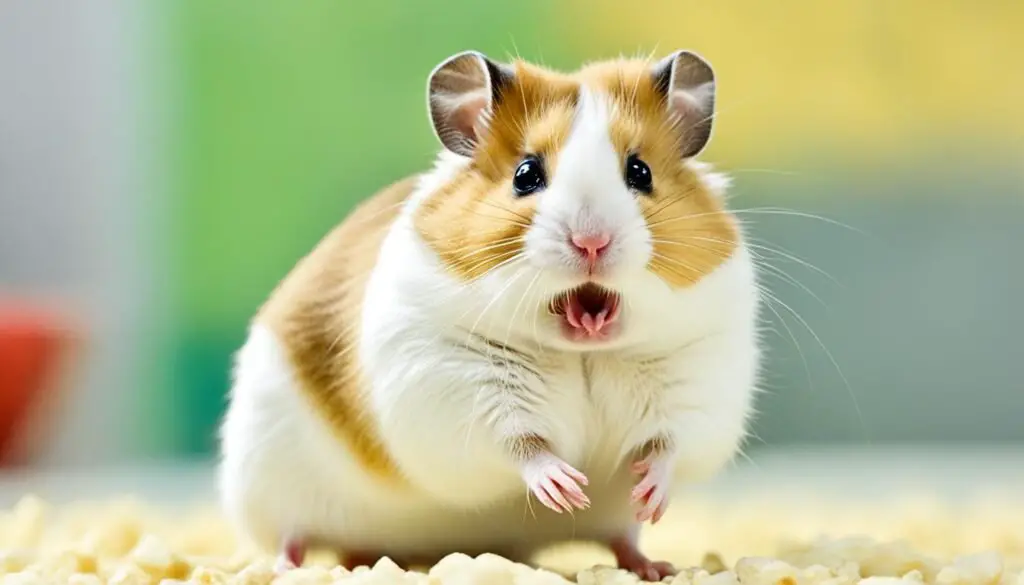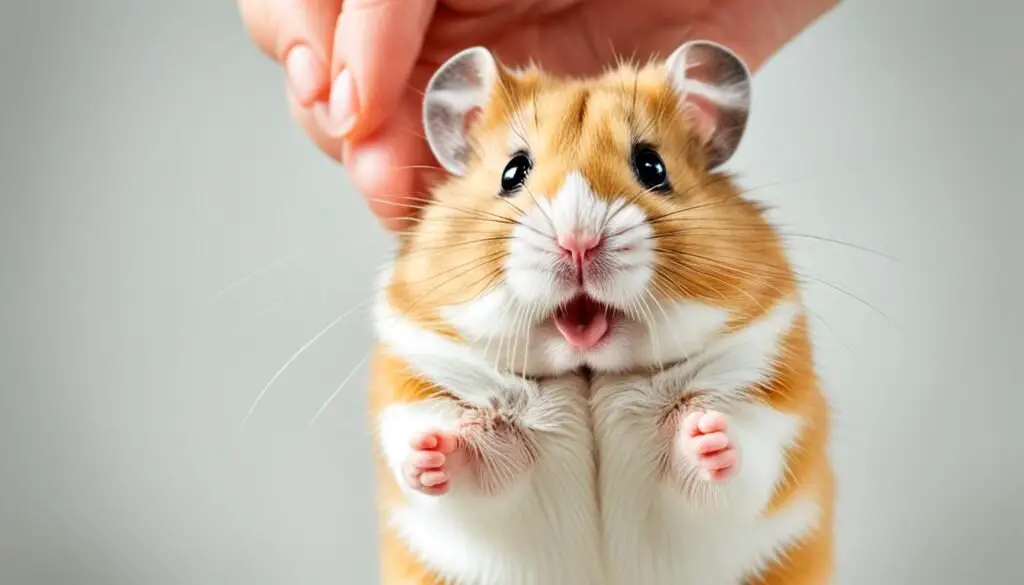Did you know that a hamster can carry up to half of its body weight in its cheek pouches? That’s right! These small rodents have an impressive ability to store food and supplies in their expandable cheek pouches. But why does your hamster choose to empty its cheeks on you? Understanding hamster behavior and decoding their cheek pouch activity can help provide insights into this curious phenomenon.
As a responsible pet owner, it’s important to delve into the reasons behind your hamster’s behavior to foster a stronger bond and ensure their well-being. So, let’s explore the fascinating world of hamster cheek pouches and uncover the secrets behind why they empty their cheeks on you.
Storing Food and Supplies
Hamsters have a natural instinct for food storage. In the wild, they utilize their cheek pouches to forage and collect food and bedding materials, which they then transport back to their burrows. This hoarding behavior is also observed in pet hamsters, who can be quite meticulous about their food stashes.
When you provide your hamster with a variety of foods, such as seeds, grains, fruits, and vegetables, they will gladly pack their cheek pouches full and transport the food to their designated storage area. Some hamsters will even hoard and hide their food stashes in a special corner of their cage.
But why do they do this? Hoarding food and supplies is an instinctual behavior for hamsters, rooted in their survival instincts. By storing extra food, they ensure a constant supply of nourishment, even if food becomes scarce. This behavior also allows hamsters to feel secure and in control of their environment.
In addition to food, you may also notice your hamster storing other items, such as bedding materials, toys, or even nesting materials. This behavior serves multiple purposes, including creating a cozy and comfortable space for rest, protecting their precious resources from others, and providing them with a sense of security.
Next time you see your hamster stuffing its cheeks or diligently arranging its food stashes, appreciate the natural instincts at play. It’s an incredible display of their survival skills and resourcefulness.
Emptying Cheek Pouches in Dangerous Situations
Hamsters have a unique defense mechanism when faced with danger. They quickly empty their cheek pouches to offload excess weight, allowing them to make a swift escape to safety. This behavior is their natural response to feeling startled or threatened, such as when someone approaches them suddenly.
If you ever notice your pet hamster emptying its cheek pouches, it’s important to understand that it is trying to protect itself from potential harm. By expelling the stored contents from its cheeks, your hamster becomes lighter and more nimble, increasing its chances of evading danger.
Whether in the wild or as pets, hamsters rely on this defense mechanism to ensure their survival. It’s a fascinating adaptation that showcases the resourcefulness of these adorable creatures.
To help your hamster feel safe and secure, provide it with a calm and quiet environment. Avoid sudden loud noises or movements that may startle them. Creating a stress-free atmosphere will reduce the frequency of their danger response and allow them to feel more comfortable in their habitat.

Understanding the various behaviors exhibited by hamsters, such as emptying their cheek pouches in dangerous situations, can help you better care for and bond with your pet. By providing a nurturing and secure environment, you can ensure your hamster’s happiness and well-being.
Stretching and Relaxing
When your hamster stretches its tiny legs, it’s a heartwarming sight that indicates it feels secure and relaxed in its environment. This behavior is a strong indication that your furry friend is enjoying its life and feeling comfortable in its surroundings.
Providing a safe and enriched habitat for your hamster is essential for promoting this stretching behavior. Make sure your hamster’s cage is spacious enough for it to move around freely. Add tunnels, hideouts, and different levels to encourage exploration. Including toys, such as exercise wheels or chew toys, can also keep your hamster entertained and mentally stimulated.
Creating a cozy and secure environment for your hamster will make it feel relaxed and content. Ensure that the temperature and humidity levels are appropriate for your hamster’s breed. Placing the cage in a calm and quiet area of your home can help reduce stress and promote relaxation.
Remember to handle your hamster gently and provide opportunities for bonding through interactive play. Spending time with your furry companion and providing them with your love and attention will further enhance their sense of security and relaxation.
So, when you see your hamster stretch those little legs, take it as a sign that they are feeling safe, secure, and at ease in their little hamster world. Keep providing them with a nurturing environment, and watch them continue to enjoy each precious moment of their life.
Freezing in Place
If you ever notice your hamster suddenly stopping in its tracks and freezing in place, don’t be alarmed. This behavior, known as freezing in place, is a natural defense mechanism that hamsters use when they detect a potential threat and feel frightened.
When a hamster freezes in place, it is essentially trying to blend in with its surroundings and stay as still as possible, hoping to go unnoticed by the perceived threat. This behavior allows the hamster to assess the situation and determine if it is safe to move or if it needs to remain hidden.
To ensure your hamster feels secure in its environment, it’s important to provide hiding places in its cage. These hiding places can be small shelters, tunnels, or even cozy bedding areas where your hamster can retreat to when it feels threatened. Having these safe spaces available will help alleviate your hamster’s fear and allow it to regain a sense of security.
Remember, freezing in place is a natural response for hamsters, and it’s essential to respect their need for safety and security. By creating a comfortable and secure habitat for your hamster, you can help minimize stress and promote their overall well-being.
Burrowing in Bedding
Hamsters have a natural instinct to burrow in their bedding, creating tunnels and hiding spots. This behavior serves several purposes, including providing a sense of security and staying safe while they sleep.
When fresh bedding is provided in their cages, you may observe your hamster diligently working to create tunnels and covered areas for their food stashes. This is a normal behavior for hamsters, as they like to hoard and store food for later consumption.
However, excessive burrowing and hiding at night when your hamster should be awake may indicate signs of stress. One possible cause of this stress is constant observation by another pet, such as a cat or dog.
If you notice your hamster showing signs of stress, it’s important to address the underlying issue and provide a safe and comfortable environment for them to thrive. Consider providing hiding places and toys in their cage to alleviate stress and promote a sense of security.
In summary, hamsters burrow in their bedding to fulfill their natural instincts, creating tunnels and covering food stashes. However, excessive burrowing may be a sign of stress, so it’s crucial to ensure your hamster feels secure in its environment.
Standing on Hind Legs
When hamsters stand on their hind legs with their front paws relaxed, it’s a delightful sight that reveals their curiosity and happiness. This is a common behavior observed in hamsters when they detect interesting smells or sounds in their surroundings. Standing upright on their hind legs allows them to better explore and investigate their environment, giving them a better vantage point to detect these intriguing stimuli.
As inquisitive creatures, hamsters have a heightened sense of smell and hearing. By standing on their hind legs, they can pick up scents more easily and pinpoint the source of intriguing smells. They also use this upright stance to listen attentively and locate the origin of captivating sounds. Standing on their hind legs is a natural behavior that showcases their alertness and curiosity.
So, if you find your hamster proudly standing on its hind legs with its front paws relaxed, it’s a sign that it is happy and inquisitive, ready to explore and discover the interesting smells or sounds that have caught its attention.

Chattering Teeth and Creeping
Is your hamster grinding its teeth or chattering away? Don’t worry, it’s a common behavior among these adorable little creatures. Hamsters may grind their teeth when they feel irritated or need some personal space. So, if you notice this behavior, it’s best to give your hamster some time alone to relax and unwind.
But why do hamsters chomp their teeth together? For male hamsters, chattering teeth can actually serve as a territorial warning. It’s their way of saying, “Stay away, this is my space!” So, if your furry friend is making those chattering sounds, it’s probably best to avoid any sudden movements that may trigger a defensive response.
Another interesting behavior to observe is when hamsters walk along the sides of their cage. This is not just random pacing. It’s actually a way for them to establish routines and familiarize themselves with new additions to their environment. So, if you see your hamster exploring the perimeter, it’s just them trying to feel more comfortable and in control of their surroundings.
